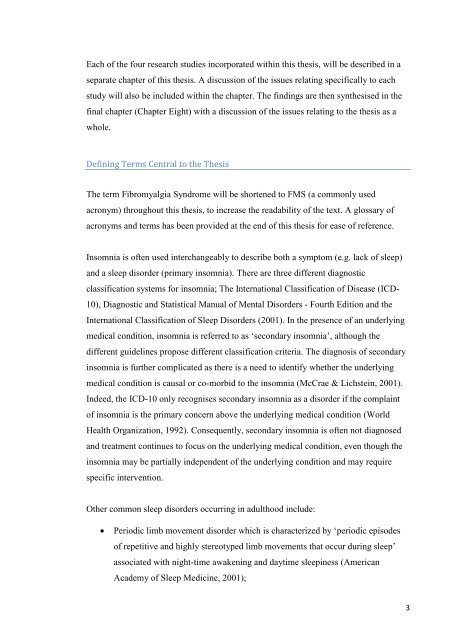Sick and Tired: Understanding and Managing Sleep Difficulties in ...
Sick and Tired: Understanding and Managing Sleep Difficulties in ...
Sick and Tired: Understanding and Managing Sleep Difficulties in ...
Create successful ePaper yourself
Turn your PDF publications into a flip-book with our unique Google optimized e-Paper software.
Each of the four research studies <strong>in</strong>corporated with<strong>in</strong> this thesis, will be described <strong>in</strong> a<br />
separate chapter of this thesis. A discussion of the issues relat<strong>in</strong>g specifically to each<br />
study will also be <strong>in</strong>cluded with<strong>in</strong> the chapter. The f<strong>in</strong>d<strong>in</strong>gs are then synthesised <strong>in</strong> the<br />
f<strong>in</strong>al chapter (Chapter Eight) with a discussion of the issues relat<strong>in</strong>g to the thesis as a<br />
whole.<br />
Def<strong>in</strong><strong>in</strong>g Terms Central to the Thesis<br />
The term Fibromyalgia Syndrome will be shortened to FMS (a commonly used<br />
acronym) throughout this thesis, to <strong>in</strong>crease the readability of the text. A glossary of<br />
acronyms <strong>and</strong> terms has been provided at the end of this thesis for ease of reference.<br />
Insomnia is often used <strong>in</strong>terchangeably to describe both a symptom (e.g. lack of sleep)<br />
<strong>and</strong> a sleep disorder (primary <strong>in</strong>somnia). There are three different diagnostic<br />
classification systems for <strong>in</strong>somnia; The International Classification of Disease (ICD-<br />
10), Diagnostic <strong>and</strong> Statistical Manual of Mental Disorders - Fourth Edition <strong>and</strong> the<br />
International Classification of <strong>Sleep</strong> Disorders (2001). In the presence of an underly<strong>in</strong>g<br />
medical condition, <strong>in</strong>somnia is referred to as „secondary <strong>in</strong>somnia‟, although the<br />
different guidel<strong>in</strong>es propose different classification criteria. The diagnosis of secondary<br />
<strong>in</strong>somnia is further complicated as there is a need to identify whether the underly<strong>in</strong>g<br />
medical condition is causal or co-morbid to the <strong>in</strong>somnia (McCrae & Lichste<strong>in</strong>, 2001).<br />
Indeed, the ICD-10 only recognises secondary <strong>in</strong>somnia as a disorder if the compla<strong>in</strong>t<br />
of <strong>in</strong>somnia is the primary concern above the underly<strong>in</strong>g medical condition (World<br />
Health Organization, 1992). Consequently, secondary <strong>in</strong>somnia is often not diagnosed<br />
<strong>and</strong> treatment cont<strong>in</strong>ues to focus on the underly<strong>in</strong>g medical condition, even though the<br />
<strong>in</strong>somnia may be partially <strong>in</strong>dependent of the underly<strong>in</strong>g condition <strong>and</strong> may require<br />
specific <strong>in</strong>tervention.<br />
Other common sleep disorders occurr<strong>in</strong>g <strong>in</strong> adulthood <strong>in</strong>clude:<br />
Periodic limb movement disorder which is characterized by „periodic episodes<br />
of repetitive <strong>and</strong> highly stereotyped limb movements that occur dur<strong>in</strong>g sleep‟<br />
associated with night-time awaken<strong>in</strong>g <strong>and</strong> daytime sleep<strong>in</strong>ess (American<br />
Academy of <strong>Sleep</strong> Medic<strong>in</strong>e, 2001);<br />
3

















